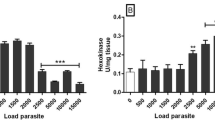Abstract
The aim of this study was to investigate how the worm Polydora sp., which induces oysters into creating mud blisters in response to an irritation within their shells, could interfere with the oyster Crassostrea gigas physiology and ethology. The impact was characterized by studying two groups of oysters (non-parasitized and parasitized) during a 30 days period: (1) the animal behaviour by analysing their valve activity (valvometry), and (2) the animal respiratory physiology by measuring in vivo the oxygen partial pressure and the specific oxygen consumption in selected tissues (heart, fast and slow adductor muscle). We also researched a putative impact on the expression of several oxidative stress genes at the heart level. Our results show that Polydora sp. is clearly an oyster’s parasite as it induces a decrease in oyster growth according to the infestation intensity. Moreover, it modifies the behaviour and the respiratory physiology of the molluscs. Infested animals opened more frequently but for less time and their level of blood oxygenation was systematically higher than healthy molluscs. These high levels of oxygenation had no effect on the oxidative metabolism of the tissues studied but they induced oxidative stress. Indeed, the superoxide dismutase gene showed a threefold increase in expression in the heart of infested oysters. A putative scenario of the weakening mechanism is proposed.







Similar content being viewed by others
References
Almeida MJ, Machado J, Coimbra J (1996) The effect of Polydora sp. infestation on the shell calcification of the oyster Crassostrea gigas. Bull Inst oceanogr 14:195–202
Briollais L, Durrieu G, Upathilake R (2006) New approach for genome scan meta-analysis of rheumatoid arthritis: a kernel-based estimation procedure. BMC Genet (in press)
Busuttil RA, Rubio M, Dollé MET, Campisi J, Vijg J (2003) Oxygen accelerates the accumulation of mutations during the senescence and immortalization of murine cells in culture. Aging Cell 2:287–294
Catherine M, Dumont F, Menanteau C, Pezeron A (1996) Anomalies des coquilles d’huîtres creuses Crassostrea gigas dues à Polydora sp., observées sur les traicts de Pen Bé et de Mesquer (Loire-Atlantique) de 1988 à 1989. Rapport interne de la DEL, IFREMER, Nantes p 47
Corbari L, Carbonel P, Massabuau JC (2004) The early life history of tissue oxygenation in crustaceans: the strategy of the myodocopid ostracod Cylindroleberis mariae. J Exp Biol 208:661–670
Forgue J, Truchot JP, Massabuau JC (1992) Low arterial PO2 in resting crustaceans is independent of blood oxygen affinity. J Exp Biol 170:257–264
Handley SJ (1998) Power to the oyster: do spionid-induced shell blister affect condition in subtidal oysters? J shellfish Res 17:1093–1099
Handley SJ, Bergquist PR (1997) Spionid polychaete infestations of intertidal Pacific oysters Crassostrea gigas (Thunberg), Mahurangi Harbour, northern New Zealand. Aquaculture 153:191–205
Härdle W (1992) Applied non parametric regression. Cambridge University press, Cambridge 349pp
His E (1976) Contribution à l’étude biologique de l’huître dans le bassin d’Arcachon. Activité valvaire de Crassostrea angulata et de Crassostrea gigas; application à l’étude de la reproduction de l’huître japonaise. Thèse de Doctorat, Université Bordeaux I, 63pp
Kent RML (1979) The influence of heavy infestation of Polydora ciliata on the flesh content of Mytilus edulis. J Mar Biolog Assoc UK 5:289–297
Kent RML (1981) The effect of Polydora ciliata on the shell strength of Mytilus edulis. J Cons Int Explor Mer 39:252–255
Legeay A, Massabuau JC (1999) Blood oxygenation requirements in resting crab (Carcinus maenas) 24 h after feeding. Can J Zool 77:784–794
Lushchak VI (2001) Oxidative stress and mechanisms of protection against it in bacteria. Biochemistry 66:592–609
Massabuau JC (2001) From low arterial- to low tissue-oxygenation strategy. An evolutionary theory. Respir physiol 128:249–261
Massabuau JC (2003) Primitive, and protective, our cellular oxygenation status? Mech Ageing Dev 124:857–863
Massabuau JC, Forgue J (1996) A field versus laboratory study of blood oxygen status in normoxic crabs at different temperatures. Can J Zool 74:423–430
Massabuau JC, Meyrand P (1996) Modulation of a neural network by physiological levels of oxygen in lobster stomatogastric ganglion. J Neurosci 16:3950–3959
Massabuau JC, Burtin B, Wheathly M (1991) How is O2 consumption maintained independent of ambient oxygen in mussel Anodonta cygnea? Respir Physiol 83:103–114
Morel Y, Barouski R (1998) Influence du stress oxydant sur la régulation des gènes. Med Sci 14:713–721
Ortmann C, Grieshaber MK (2003) Energy metabolism and valve closure behaviour in the Asian clam Corbicula fluminea. J Exp Biol 206:4167–4178
Poulin R (1999) The functional importance of parasites in animal communities: many roles at many levels? Int J Parasitol 29:903–914
Ruellet T (2004) Infestation des coquilles d’huîtres Crassostrea gigas par les polydores en Basse-Normandie: recommandations et mise au point d’un traitement pour réduire cette nuisance. Thèse de Doctorat, Université de Caen, Basse-Normandie, 536pp
Silverman BW (1986) Density estimation for statistics and data analysis, monographs on statistics and applied probability. Chapman & Hall, London
Tran D, Boudou A, Massabuau JC (2000) Mechanism for maintaining oxygen consumption under varying oxygenation levels in the freshwater clam Corbicula fluminea. Can J Zool 78:2027–2036
Tran D, Boudou A, Massabuau JC (2002) Relationship between feeding-induced ventilatory activity and bioaccumulation of dissolved and algal-bound cadmium in the Asiatic clam Corbicula fluminea. Environ Toxicol Chem 21:327–333
Tran D, Ciret P, Ciutat A, Durrieu G, Massabuau JC (2003) Estimation of potential and limits of bivalve closure response to detect contaminants: application to cadmium. Environ Toxicol Chem 22:914–920
Vanderkooi JM, Erecinska M, Silver IA (1991) Oxygen in mammalian tissue: methods of measurements and affinities of various reactions. Am J Physiol 260:C1131–C1150
Viarengo A, Burlando B, Cavaletto M, Marchi B, Ponzano E, Blasco J (1999) Role of metallothionein against oxidative stress in the mussel Mytilus galloprovincialis. Am J Physiol Regul Integr Comp Physiol 277:1612–1619
Author information
Authors and Affiliations
Corresponding author
Additional information
Communicated by S.A. Poulet.
Rights and permissions
About this article
Cite this article
Chambon, C., Legeay, A., Durrieu, G. et al. Influence of the parasite worm Polydora sp. on the behaviour of the oyster Crassostrea gigas: a study of the respiratory impact and associated oxidative stress. Mar Biol 152, 329–338 (2007). https://doi.org/10.1007/s00227-007-0693-1
Received:
Accepted:
Published:
Issue Date:
DOI: https://doi.org/10.1007/s00227-007-0693-1




